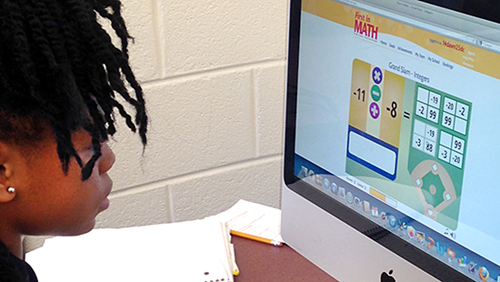One of the benefits of the First In Math Online Program’s design is that it fits into any teacher’s world.
“Because there is no one correct way to teach math, our goal is to be sure that each teacher understands the powerful tool they have at their fingertips, and how it can help their students,” explains Implementation Specialist Shawn Collier. A former teacher, Collier suggests that while most students need specific math practice, some kids just need to learn how to learn.

One key to a successful implementation is to help teachers better understand why First In Math’s open palette of activities is better than locking students in to certain areas and out of others. “We need students to become interested enough that they want to touch math on their own. Sometimes it may be something slightly below their skill level, sometimes it may be something above their skill level, but what is most important is that it is an autonomous act,” explains Collier. “There will be times when the teacher says, today's area of focus will be the multiplication gym, but when a student logs on they should think of their homepage as a gateway to explore math—sometimes with guidance and sometimes just because it’s fun.”
Implementation Strategist Monica Patel agrees. “When I conduct sessions in person at a school, I let students make the choice of what works best for them, given a set of options.” Patel, a former teacher with extensive experience in differentiation, has students rotate through the computer lab for one class period each.
“First, I demonstrate to students several different fact-fluency activities that yield the same objective. Then they are given five minutes to find which one works best for them. I always allow students with ‘timer anxiety’ to opt out of timed modules and select untimed Bonus modules,” adds Patel, who points out that another important component to consider is the reality that some kids need to learn how NOT to be intimidated by math.
During the session, it becomes apparent when a student is engaged and on-task to complete their individual goals—they have found their instructional level. As students play, perseverance and task-completion are recognized and rewarded with First In Math’s electronic ‘stickers’ and positive messages.
“As a by-product, I see students proactively apply Standards of Mathematical Practices until they are able to solve problems accurately, and they attend to precision to earn maximum points,” says Patel. “Because their goal is to earn as much as it is to learn, students also begin to apply strategy. Reviewing their errors and repeating the practice is among the commonly-used strategies that we are excited to see. Academic skills can be acquired with good teaching and effort, but executive-functioning skills are learned through experience, by doing.”
According to Patel, two aspects of these sessions generate great excitement among teachers. Given that in each class there is a wide range of skill levels, it would typically fall on teachers to differentiate math tasks. In the FIM sessions, all students work toward the same learning objective, but each works on a task that they can best complete accurately. “Each student finds a task that matches his or her skill level—their paths are parallel and lead to the same academic outcome.”
Of even greater importance is the fact that the semi-autonomous nature of the sessions leads students to deep engagement and self-discovery of their learning style.
Patel says she is often most exited about what happens when she is ready to leave. “Typically, after the sessions, many teachers are quick to shift the class into ‘guided-practice’ mode with word-problem solving as the next objective of the session. Students excitedly transition to this activity and even use notebooks to work out solutions!”
editor’s note: First In Math offers regularly-scheduled instructional Webinars each week. To reserve a spot, click the Webinars icon at the top of your Team Leader, Principal or Administrator Homepage.